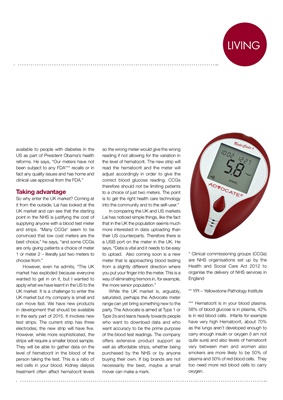
LIVING
available to people with diabetes in the
US as part of President Obama's health
reforms. He says, "Our meters have not
been subject to any FDA*** recalls or in
fact any quality issues and has home and
clinical use approval from the FDA."
Taking advantage
So why enter the UK market? Coming at
it from the outside, Lai has looked at the
UK market and can see that the starting
point in the NHS is justifying the cost of
supplying anyone with a blood test meter
and strips. "Many CCGs* seem to be
convinced that low cost meters are the
best choice," he says, "and some CCGs
are only giving patients a choice of meter
1 or meter 2 - literally just two meters to
choose from."
However, even he admits, "The UK
market has exploded because everyone
wanted to get in on it, but I wanted to
apply what we have learnt in the US to the
UK market. It is a challenge to enter the
UK market but my company is small and
can move fast. We have new products
in development that should be available
in the early part of 2015. It involves new
test strips. The current strip has three
electrodes; the new strip will have five.
However, while more sophisticated, the
strips will require a smaller blood sample.
They will be able to gather data on the
level of hematocrit in the blood of the
person taking the test. This is a ratio of
red cells in your blood. Kidney dialysis
treatment often affect hematocrit levels
so the wrong meter would give the wrong
reading if not allowing for the variation in
the level of hematocrit. The new strip will
read the hematocrit and the meter will
adjust accordingly in order to give the
correct blood glucose reading. CCGs
therefore should not be limiting patients
to a choice of just two meters. The point
is to get the right health care technology
into the community and to the self-user."
In comparing the UK and US markets
Lai has noticed simple things, like the fact
that in the UK the population seems much
more interested in data uploading than
their US counterparts. Therefore there is
a USB port on the meter in the UK. He
says, "Data is vital and it needs to be easy
to upload. Also coming soon is a new
meter that is approaching blood testing
from a slightly different direction where
you put your finger into the meter. This is a
way of eliminating tremors in, for example,
the more senior population."
While the UK market is, arguably,
saturated, perhaps the Advocate meter
range can yet bring something new to the
party. The Advocate is aimed at Type 1 or
Type 2s and leans heavily towards people
who want to download data and who
want accuracy to be the prime purpose
of the blood test readings. The company
offers extensive product support as
well as affordable strips, whether being
purchased by the NHS or by anyone
buying their own. If big brands are not
necessarily the best, maybe a small
mover can make a mark.
* Clinical commissioning groups (CCGs)
are NHS organisations set up by the
Health and Social Care Act 2012 to
organise the delivery of NHS services in
England
** YPI - Yellowstone Pathology Institute
*** Hematocrit is in your blood plasma.
58% of blood glucose is in plasma, 42%
is in red blood cells. Infants for example
have very high Hematocrit, about 70%
as the lungs aren't developed enough to
carry enough insulin or oxygen (I am not
quite sure) and also levels of hematocrit
vary between men and women also
smokers are more likely to be 50% of
plasma and 50% of red blood cells. They
too need more red blood cells to carry
oxygen.